Sustainable Operations: A Systematic Operational Performance Evaluation Framework for Public–Private Partnership Transportation Infrastructure Projects
Abstract
1. Introduction
2. Literature Review
2.1. Characteristics of PPP Transportation Infrastructure Operation
2.2. Assessment of Operation Performance in PPP Transportation Infrastructure
2.3. Methods for System Dynamic Performance Assessment
3. Materials and Methods
4. Construction of an Index System
- (1)
- Combination of comprehensive indicators: the evaluation system should consider the demands of all stakeholders to achieve value co-creation.
- (2)
- Combination of financial and non-financial indicators: the performance evaluation of PPP projects not only needs to consider the financial operation capabilities of the project, but also the internal control management of the project (including the efficiency and effectiveness of public services), its social environmental impact (sustainability), and the satisfaction of all stakeholders.
- (3)
- Combination of static and dynamic indicators: the selection of indicators should include factors such as the organizational structure that is stable at the beginning of the project and has a long-term impact on project performance, as well as factors such as service quality, which is dynamically updated as the project progresses, affected by the organizational external environment, and affecting project performance dynamically and continuously.
- (4)
- Combination of commonality and individuality indicators: it is necessary to deepen and refine the current commonality framework of transportation infrastructure performance evaluation and introduce the individual requirements of PPP project performance evaluation.
- (1)
- Financial ability
- (2)
- Multi-stakeholders’ satisfaction
- (3)
- Operation and maintenance management
- (4)
- Sustainability
5. System Structural Analysis
5.1. Questionaire Design and Distribution
5.2. Reliability Analysis
5.3. SEM Construction and Operating Results
6. System Dynamic Modeling
6.1. Causality Diagram
6.2. Select System Variables
6.3. Build System Flow Diagram
6.4. Model Validation
6.4.1. Structural Verification Result
6.4.2. Structure-Oriented Behavior Test Result
6.4.3. Behavior Test Result
7. Case Analysis
8. Discussion and Conclusions
8.1. Managerial Implications
8.2. Theoretical Contributions
8.3. Limitations and Future Research
Author Contributions
Funding
Institutional Review Board Statement
Informed Consent Statement
Data Availability Statement
Conflicts of Interest
References
- Wang, S.; Pang, M.; Wang, Y. Establishment of PPP Body of Knowledge in China. In Annual Report on the Development of PPP in China; Wang, T., Han, Z., Yang, Y., Wang, S., Li, K., Eds.; Springer: Singapore, 2020; pp. 25–48. [Google Scholar]
- Chan, A.P.C.; Lam, P.T.I.; Chan, D.W.M.; Cheung, E.; Ke, Y. Critical success factors for PPPs in infrastructure developments: Chinese perspective. J. Constr. Eng. Manag. 2010, 136, 484–494. [Google Scholar] [CrossRef]
- China Public Private Partnerships Center. Available online: https://www.cpppc.org/ (accessed on 3 May 2023).
- Sanger, M. Supporting the balanced scorecard. Work Study 1998, 47, 197–200. [Google Scholar] [CrossRef]
- Glendinning, R. The concept of value for money. Int. J. Public Sect. Manag. 1988, 1, 42–50. [Google Scholar] [CrossRef]
- Liang, Q.; Hu, H. Uncertainty analysis of value for money assessment for public-private partnership projects. J. Shanghai Jiaotong Univ. 2017, 22, 672–681. [Google Scholar] [CrossRef]
- Wibowo, A.; Sundermeier, M. Developing a fuzzy value-for-money analysis model for annuity-based public-private partnership infrastructure projects under consideration of risk mitigation capability. J. Constr. Eng. Manag. 2020, 146, 04020081. [Google Scholar] [CrossRef]
- Amos, D.; Musa, Z.N.; Au-Yong, C.P. A review of facilities management performance measurement. Prop. Manag. 2019, 37, 490–511. [Google Scholar] [CrossRef]
- Kagioglou, M.; Cooper, R.; Aouad, G. Performance management in construction: A conceptual framework. Constr. Manag. Econ. 2001, 19, 85–95. [Google Scholar] [CrossRef]
- Liu, J.; Love PE, D.; Smith, J.; Regan, M.; Palaneeswaran, E. Review of performance measurement: Implications for public–private partnerships. Built Environ. Proj. Asset Manag. 2015, 5, 35–51. [Google Scholar] [CrossRef]
- Kober, R.; Northcott, D. Testing cause-and-effect relationships within a balanced scorecard. Account. Financ. 2021, 61, 1815–1849. [Google Scholar] [CrossRef]
- Ecem Yildiz, A.; Dikmen, I.; Talat Birgonul, M. Using system dynamics for strategic performance management in construction. J. Manag. Eng. 2020, 36, 04019051. [Google Scholar] [CrossRef]
- Othman, R. Enhancing the effectiveness of the balanced scorecard with scenario planning. Int. J. Product. Perform. Manag. 2008, 57, 259–266. [Google Scholar] [CrossRef]
- Mladenovic, G.; Vajdic, N.; Wündsch, B.; Temeljotov-Salaj, A. Use of key performance indicators for PPP transport projects to meet stakeholders’ performance objectives. Built Environ. Proj. Asset Manag. 2013, 3, 228–249. [Google Scholar] [CrossRef]
- Liang, Y.; Wang, H. Sustainable performance measurements for public–private partnership projects: Empirical evidence from China. Sustainability 2019, 11, 3653. [Google Scholar] [CrossRef]
- Rahman, H.Z.; Miraj, P.; Andreas, A. Exploring public–private partnership scheme in operation and maintenance stage of railway project. Sustainability 2019, 11, 6517. [Google Scholar] [CrossRef]
- South, A.; Eriksson, K.; Levitt, R. How infrastructure public–private partnership projects change over project development phases. Proj. Manag. J. 2018, 49, 62–80. [Google Scholar] [CrossRef]
- Xu, Z.; Wang, X.; Xiao, Y.; Yuan, J. Modeling and performance evaluation of PPP projects utilizing IFC extension and enhanced matter-element method. Eng. Constr. Archit. Manag. 2020, 27, 1763–1794. [Google Scholar] [CrossRef]
- Cheng, Z.; Wang, H.; Xiong, W.; Zhu, D.; Cheng, L. Public–private partnership as a driver of sustainable development: Toward a conceptual framework of sustainability-oriented PPP. Environ. Dev. Sustain. 2021, 23, 1043–1063. [Google Scholar] [CrossRef]
- Liu, C.; Guo, X.; Men, R. Performance Evaluation of Urban Rail Transit PPP Mode Project; Springer: Cham, Switzerland, 2021; pp. 399–412. [Google Scholar]
- Hajarolasvadi, H.; Shahhosseini, V. A system-dynamic model for evaluating the effect of person-team fit on project performance. J. Constr. Eng. Manag. 2022, 148, 04022126. [Google Scholar] [CrossRef]
- Faturechi, R.; Miller-Hooks, E. Measuring the performance of transportation infrastructure systems in disasters: A comprehensive review. J. Infrastruct. Syst. 2015, 21, 04014025. [Google Scholar] [CrossRef]
- Wang, D.; Wang, X.; Wang, L.; Liu, H.J.; Jia, X. A performance measurement system for public–private partnerships: Integrating stakeholder influence and process trans-period effect. Int. J. Product. Perform. Manag. 2021, 72, 137–155. [Google Scholar] [CrossRef]
- Kim, S.Y.; Thuc, L.D. Life cycle performance measurement in public-private partnership infrastructure projects. J. Infrastruct. Syst. 2021, 27, 06021001. [Google Scholar] [CrossRef]
- Zhu, J.; Chen, M.; Lei, Q. Study on Evaluation Method of the Total Asset Value of National and Provincial Highway Infrastructure. In Proceedings of the International Conference on Construction and Real Estate Management, Stockholm, Sweden, 24–25 August 2020; pp. 793–803. [Google Scholar]
- Tan, R.P.; Pan, L.L.; Xu, M.M.; He, X.J. Transportation infrastructure, economic agglomeration and non-linearities of green total factor productivity growth in China: Evidence from partially linear functional coefficient model. Transp. Policy 2022, 129, 1–13. [Google Scholar] [CrossRef]
- Shepherd, S.P. A review of system dynamics models applied in transportation. Transp. B Transp. Dyn. 2014, 2, 83–105. [Google Scholar] [CrossRef]
- Lop, N.S.; Ismail, K.; Isa, H.M. A conceptual framework of performance measurement tool for private finance initiative projects in Malaysia. J. Build. Perform. 2018, 9, 1–12. [Google Scholar]
- Gorman, M.F. Evaluating the public investment mix in US freight transportation infrastructure. Transp. Res. Part A Policy Pract. 2008, 42, 1–14. [Google Scholar] [CrossRef]
- Lee, J.I.; Lee, H.-S.; Park, M. Contractor liquidity evaluation model for successful public housing projects. J. Constr. Eng. Manag. 2018, 144, 04018109. [Google Scholar] [CrossRef]
- Belikova, D.D.; Safiullin, R.N. The design and evaluation of a telematic automated system of weight control for heavy vehicles. Infrastructures 2022, 7, 86. [Google Scholar] [CrossRef]
- Ozbek, M.E.; de la Garza, J.M.; Triantis, K. Data and modeling issues faced during the efficiency measurement of road maintenance using data envelopment analysis. J. Infrastruct. Syst. 2010, 16, 21–30. [Google Scholar] [CrossRef]
- Makovšek, D.; Moszoro, M. Risk pricing inefficiency in public–private partnerships. Transp. Rev. 2018, 38, 298–321. [Google Scholar] [CrossRef]
- Hu, X.; Han, J. Highway project value of money assessment under PPP mode and its application. J. Adv. Transp. 2018, 2018, 1802671. [Google Scholar] [CrossRef]
- Zhao, J.; Liu Henry, J.; Sing Michael, C.P.; Jin, X.; Ginige, K. Delivery of transport infrastructure assets: Decision-making model to ensure value for money. J. Infrastruct. Syst. 2021, 27, 05020008. [Google Scholar] [CrossRef]
- Kaplan, R.S.; Norton, D.P. Putting the balanced scorecard to work. Econ. Impact Knowl. 1998, 71, 315–324. [Google Scholar]
- Eom Creed, S.; Yun Seok, H.; Paek Joon, H. Subcontractor evaluation and management framework for strategic partnering. J. Constr. Eng. Manag. 2008, 134, 842–851. [Google Scholar] [CrossRef]
- Jin, Z.; Deng, F.; Li, H.; Skitmore, M. Practical framework for measuring performance of international construction firms. J. Constr. Eng. Manag. 2013, 139, 1154–1167. [Google Scholar] [CrossRef]
- Sirin, O.; Gunduz, M.; Moussa, A. Application of tools of quality function deployment and modified balanced scorecard for optimal allocation of pavement management resources. IEEE Access 2020, 8, 76399–76410. [Google Scholar] [CrossRef]
- Liu, J.; Guo, Y.; Martek, I.; Chen, C.; Tian, J. A phase-oriented evaluation framework for China’s PPP projects. Eng. Constr. Archit. Manag. 2022, 29, 3737–3753. [Google Scholar] [CrossRef]
- Ming, Z.; Hu, Y.; Zheng, M. The Performance Evaluation of Expressway PPP Project during Operation Period Based on RF. In Proceedings of the ICCREM 2021: Challenges of the Construction Industry under the Pandemic, Beijing, China, 16–17 October 2021; pp. 917–924. [Google Scholar]
- Mohamad, R.; Ismail, S.; Mohd Said, J. Performance indicators for public private partnership (PPP) projects in Malaysia. J. Econ. Adm. Sci. 2018, 34, 137–152. [Google Scholar] [CrossRef]
- Hossain, M.; Guest, R.; Smith, C. Performance indicators of public private partnership in Bangladesh. Int. J. Product. Perform. Manag. 2019, 68, 46–68. [Google Scholar] [CrossRef]
- Samee, K.; Pongpeng, J. Structural equation model for construction equipment management affecting project and corporate performance. KSCE J. Civ. Eng. 2016, 20, 1642–1656. [Google Scholar] [CrossRef]
- Chen Yong, Q.; Zhang Yang, B.; Liu Jun, Y.; Mo, P. Interrelationships among critical success factors of construction projects based on the structural equation model. J. Manag. Eng. 2012, 28, 243–251. [Google Scholar] [CrossRef]
- Yuan, J.; Li, W.; Zheng, X.; Skibniewski Mirosław, J. Improving operation performance of public rental housing delivery by PPPs in China. J. Manag. Eng. 2018, 34, 04018015. [Google Scholar] [CrossRef]
- Leon, H.; Osman, H.; Georgy, M.; Elsaid, M. System dynamics approach for forecasting performance of construction projects. J. Manag. Eng. 2018, 34, 04017049. [Google Scholar] [CrossRef]
- Fitch Gregory, J.; Odeh, I.; Kautz, F.; Ibbs, C.W. System dynamics models for the valuation of real options in p3 concession project agreements. J. Infrastruct. Syst. 2018, 24, 04017047. [Google Scholar] [CrossRef]
- Rostamnezhad, M.; Nasirzadeh, F.; Khanzadi, M.; Jarban, M.J.; Ghayoumian, M. Modeling social sustainability in construction projects by integrating system dynamics and fuzzy-dematel method: A case study of highway project. Eng. Constr. Archit. Manag. 2020, 27, 1595–1618. [Google Scholar] [CrossRef]
- Pagoni, E.G.; Patroklos, G. A system dynamics model for the assessment of national public–private partnership programmes’ sustainable performance. Simul. Model. Pract. Theory 2019, 97, 101949. [Google Scholar] [CrossRef]
- Liu, B.; Wang, X.; Cao, L. Simulation study on dynamic formation mechanism about competitiveness of China’s construction industry based on the combination of SEM and SD. Syst. Eng. Theory Pract. 2010, 11, 2063–2070. [Google Scholar]
- Wang, C.; Zou, F.; Yap JB, H.; Wood, L.C.; Li, H.; Ding, L. System dynamics tool for entropy-based risk control on sleeve grouting in prefabricated buildings. Eng. Constr. Archit. Manag. 2022. [Google Scholar] [CrossRef]
- Kassem, M.A.; Khoiry, M.A.; Hamzah, N. Assessment of the effect of external risk factors on the success of an oil and gas construction project. Eng. Constr. Archit. Manag. 2020, 27, 2767–2793. [Google Scholar] [CrossRef]
- Narayanan, A. A review of eight software packages for structural equation modeling. Am. Stat. 2012, 66, 129–138. [Google Scholar] [CrossRef]
- Badamasi, A.A.; Aryal, K.R.; Makarfi, U.U.; Dodo, M. Drivers and barriers of virtual reality adoption in UK AEC industry. Eng. Constr. Archit. Manag. 2022, 29, 1307–1318. [Google Scholar] [CrossRef]
- Xu, B.; Yu, H. Study to the Performance Evaluation of Construction Enterprise Project Management Based on the Bsc. In Proceedings of the 2008 International Conference on Information Management, Innovation Management and Industrial Engineering, Taipei, Taiwan, 19–21 December 2008; pp. 242–246. [Google Scholar]
- Sánchez-Silva, M.; Frangopol Dan, M.; Padgett, J.; Soliman, M. Maintenance and operation of infrastructure systems: Review. J. Struct. Eng. 2016, 142, F4016004. [Google Scholar] [CrossRef]
- Hou, W.; Wang, L. Research on Financial Early Warning of PPP Projects from Refinancing Perspective. In Proceedings of the nternational Conference on Construction and Real Estate Management, Banff, AB, Canada, 21–24 May 2019; pp. 306–313. [Google Scholar]
- Mony, S.; Ramachandran, N. Impact of Management Control Systems on Sponsors’ Profitability in PPP Infrastructure Ventures. In Financial Issues in Emerging Economies: Special Issue Including Selected Papers from II International Conference on Economics and Finance, 2019, Bengaluru, India; Biswas, R., Michaelides, M., Eds.; Research in Finance 36; Emerald Publishing Ltd.: Bradford, UK, 2020; pp. 123–143. [Google Scholar]
- Kim, J.-M.; Kim, T.; Ahn, S. Loss assessment for sustainable industrial infrastructure: Focusing on bridge construction and financial losses. Sustainability 2020, 12, 5316. [Google Scholar] [CrossRef]
- Zhang, H.; Wang, B. Dynamic Research on Stakeholders of the Utility Tunnel PPP Project. In Proceedings of the ICCREM International Conference on Construction and Real Estate Management, Charleston, SC, USA, 9–10 August 2018; pp. 114–120. [Google Scholar]
- Hua, J.; Zhang, R.; Gu, J. Three-Dimensional Comprehensive Analysis of Transportation Network Operation Conditions. In Proceedings of the 19th COTA International Conference of Transportation Professionals, Nanjing, China, 6–8 July 2019; pp. 3286–3296. [Google Scholar]
- Zhou, B.; Wang, C.; Liu, F.; Wang, E. Whole risk assessment system and management system of urban road tunnel operation stage. J. Highw. Transp. Res. Dev. 2020, 14, 94–101. [Google Scholar] [CrossRef]
- Jovanovic, S.; Bozovic, D. Optimal structure and two case study implementations of a railway maintenance management system. J. Manag. Eng. 2015, 31, 05014013. [Google Scholar] [CrossRef]
- Quelhas Adriane, D.; Filho José Rodrigues, F.; Neto Julio, V.; Pereira, V. Model to measure adherence of culture, climate, and organizational behavior in a construction company. J. Manag. Eng. 2019, 35, 05019003. [Google Scholar] [CrossRef]
- Shi, K.; Feng, P.; Liu, Z.; Wang, N. Design and Application Research on Information Management System of Intelligent Maintenance Equipment in Urban Rail Transit. In Proceedings of the 20th COTA International Conference of Transportation Professionals, Xi’an, China, 16–19 December 2021; pp. 535–543. [Google Scholar]
- Schmitt, N. Uses and abuses of coefficient alpha. Psychol. Assess. 1996, 8, 350. [Google Scholar] [CrossRef]
- Kaiser, H.F. An index of factorial simplicity. Psychometrika 1974, 39, 31–36. [Google Scholar] [CrossRef]
- Asparouhov, T.; Muthén, B. Exploratory structural equation modeling. Struct. Equ. Model. A Multidiscip. J. 2009, 16, 397–438. [Google Scholar] [CrossRef]
- Satorra, A.; Bentler, P.M. Corrections to Test Statistics and Standard Errors in Covariance Structure Analysis. In Latent Variables Analysis: Applications for Developmental Research; Sage Publications Inc.: Thousand Oaks, CA, USA, 1994; pp. 399–419. [Google Scholar]
- Shrestha, N. Factor analysis as a tool for survey analysis. Am. J. Appl. Math. Stat. 2021, 9, 4–11. [Google Scholar] [CrossRef]
- Fornell, C.; Larcker, D.F. Evaluating structural equation models with unobservable variables and measurement error. J. Mark. Res. 1981, 18, 39–50. [Google Scholar] [CrossRef]
- Papachristos, G.; Jain, N.; Burman, E.; Zimmermann, N.; Wu, X.; Liu, P.; Mumovic, D.; Lin, B.; Davies, M.; Edkins, A. Low carbon building performance in the construction industry: A multi-method approach of system dynamics and building performance modelling. Constr. Manag. Econ. 2020, 38, 856–876. [Google Scholar] [CrossRef]
- Barlas, Y. Formal aspects of model validity and validation in system dynamics. Syst. Dyn. Rev. 1996, 12, 183–210. [Google Scholar] [CrossRef]
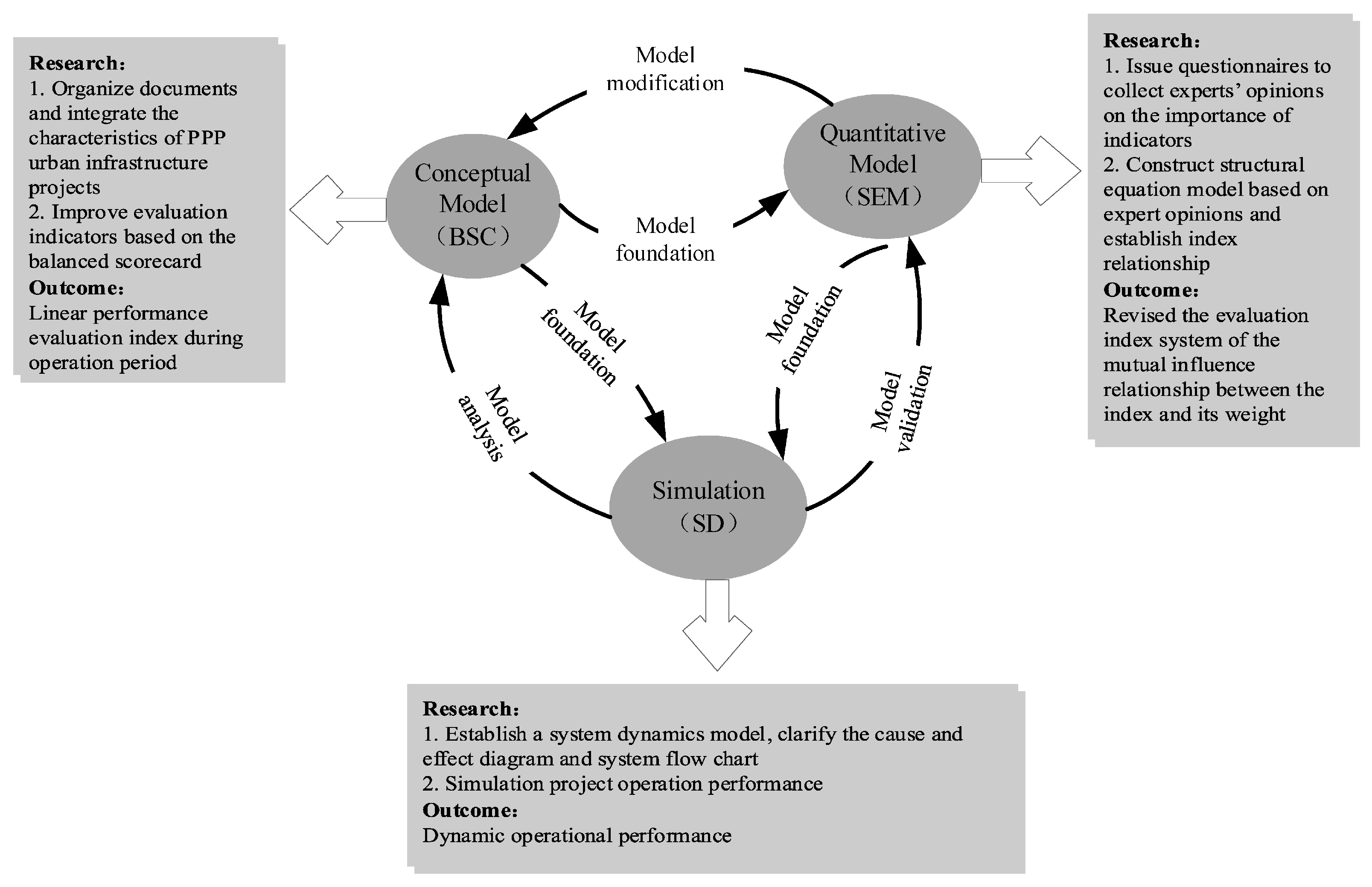
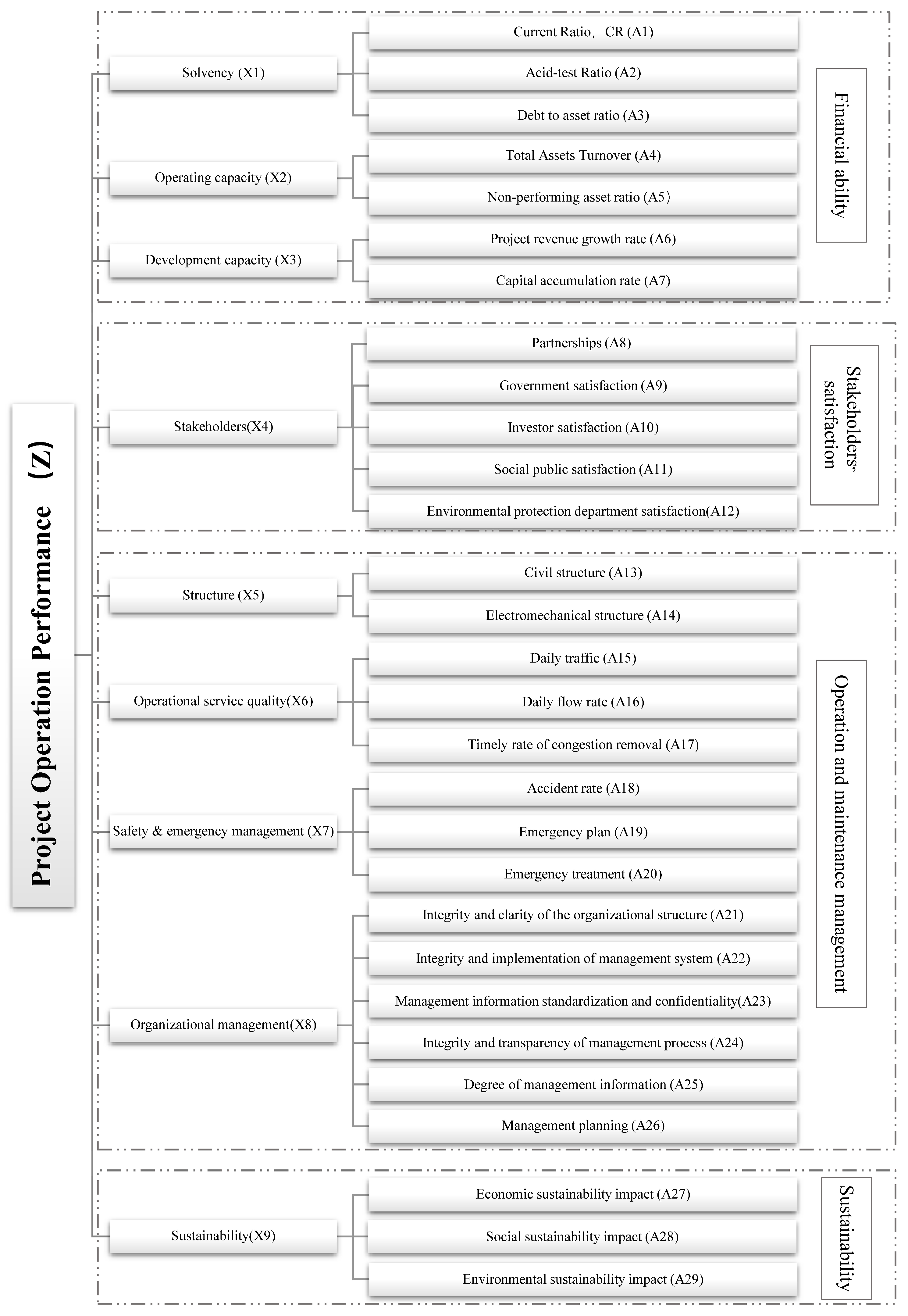

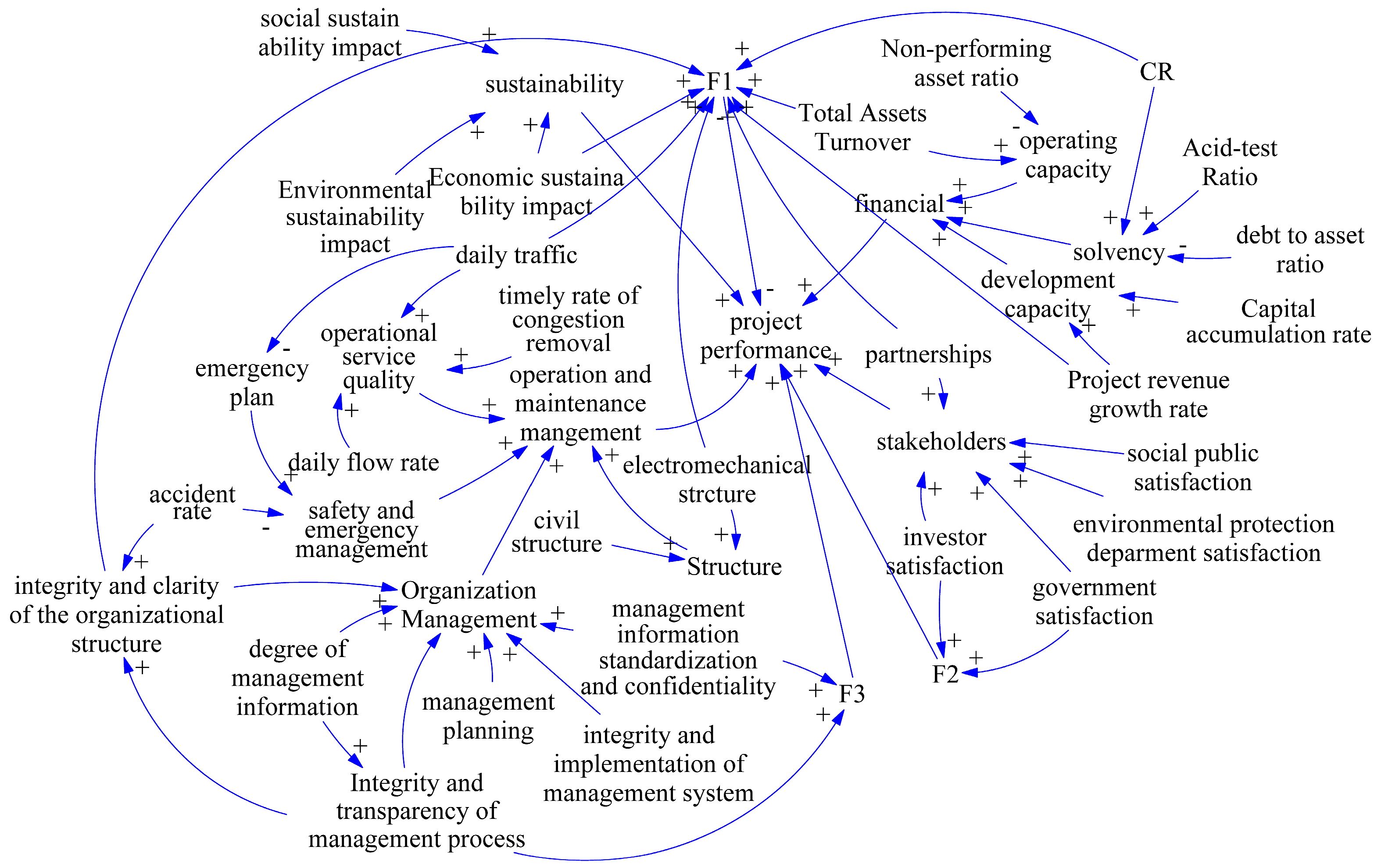
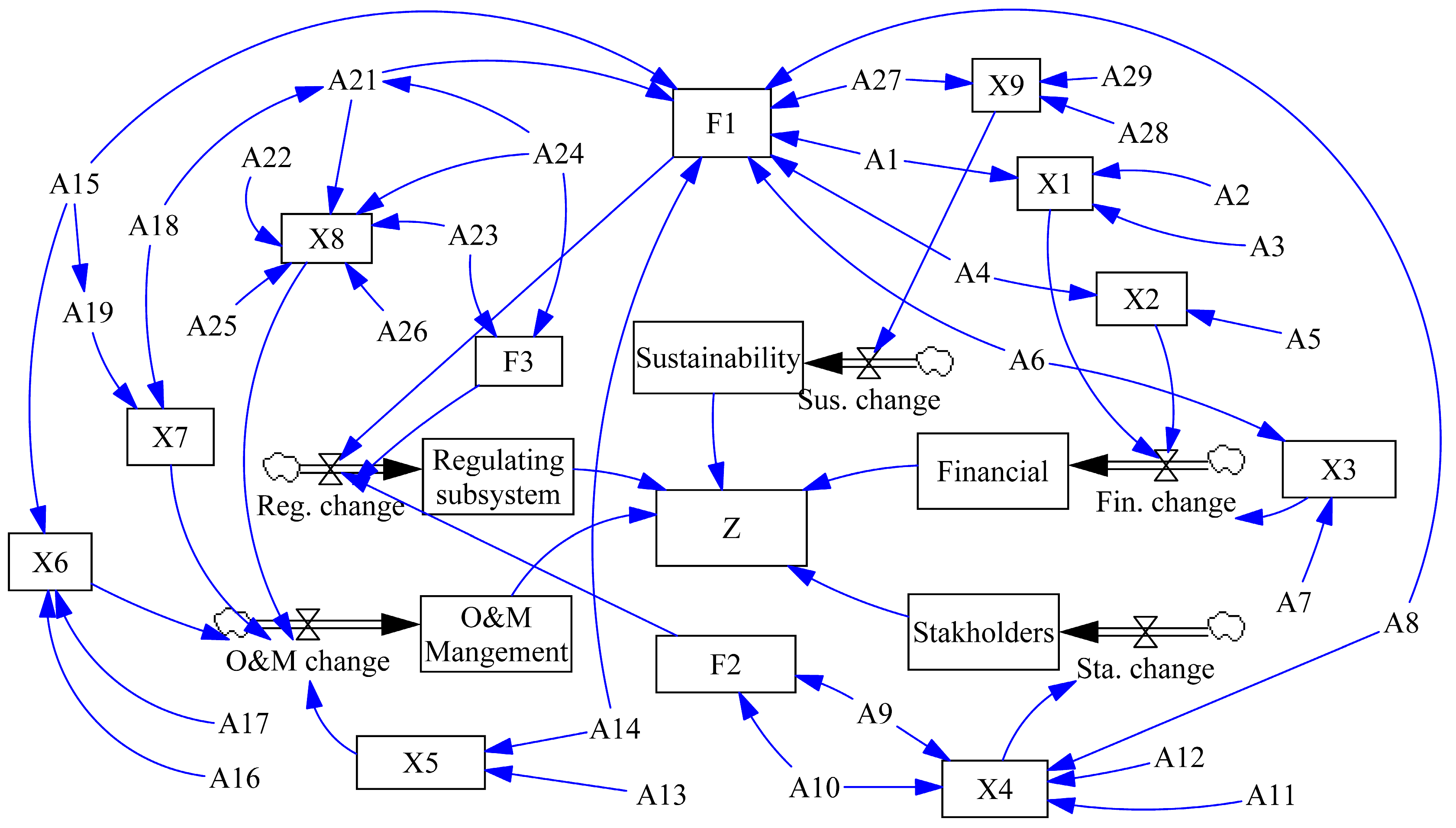
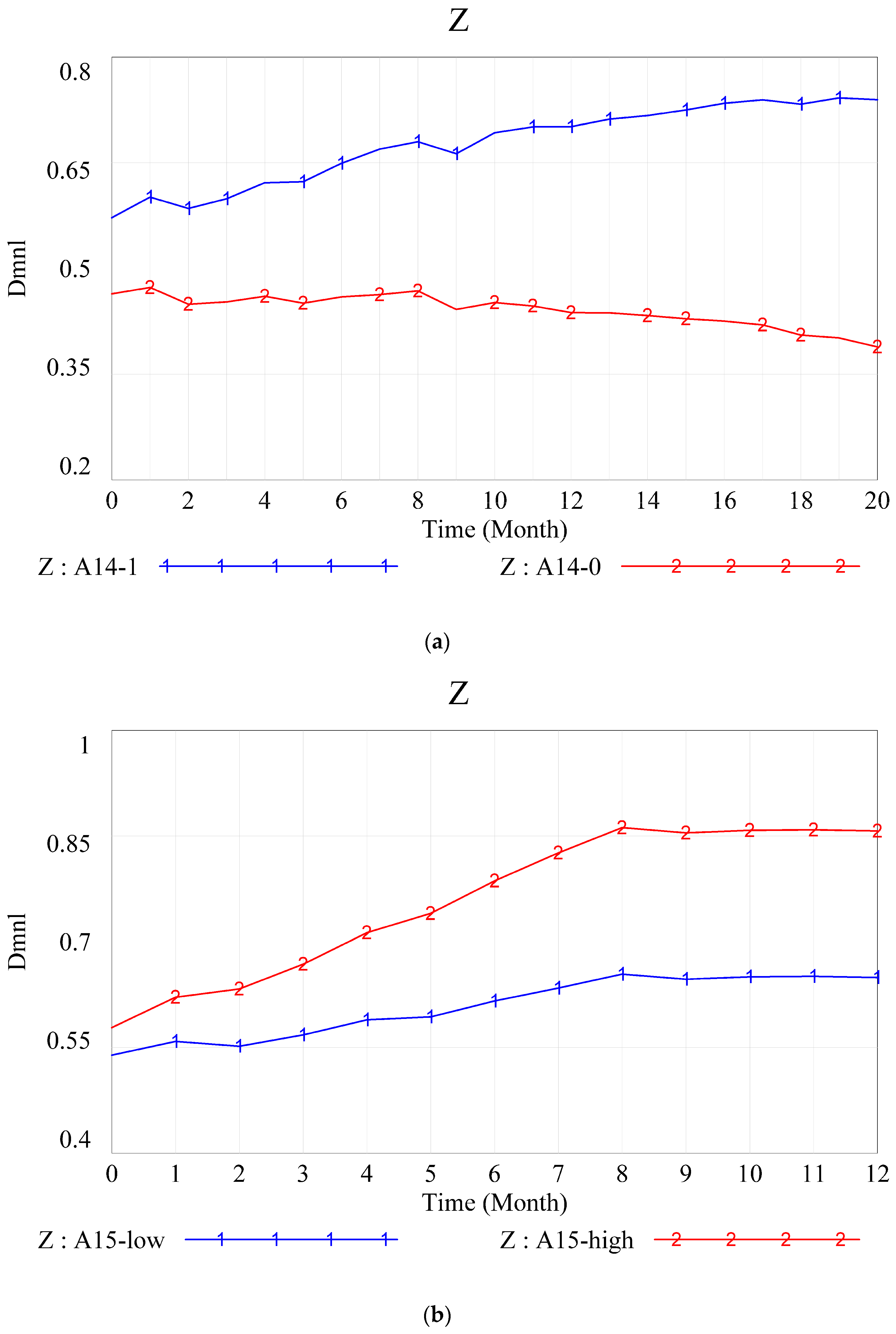

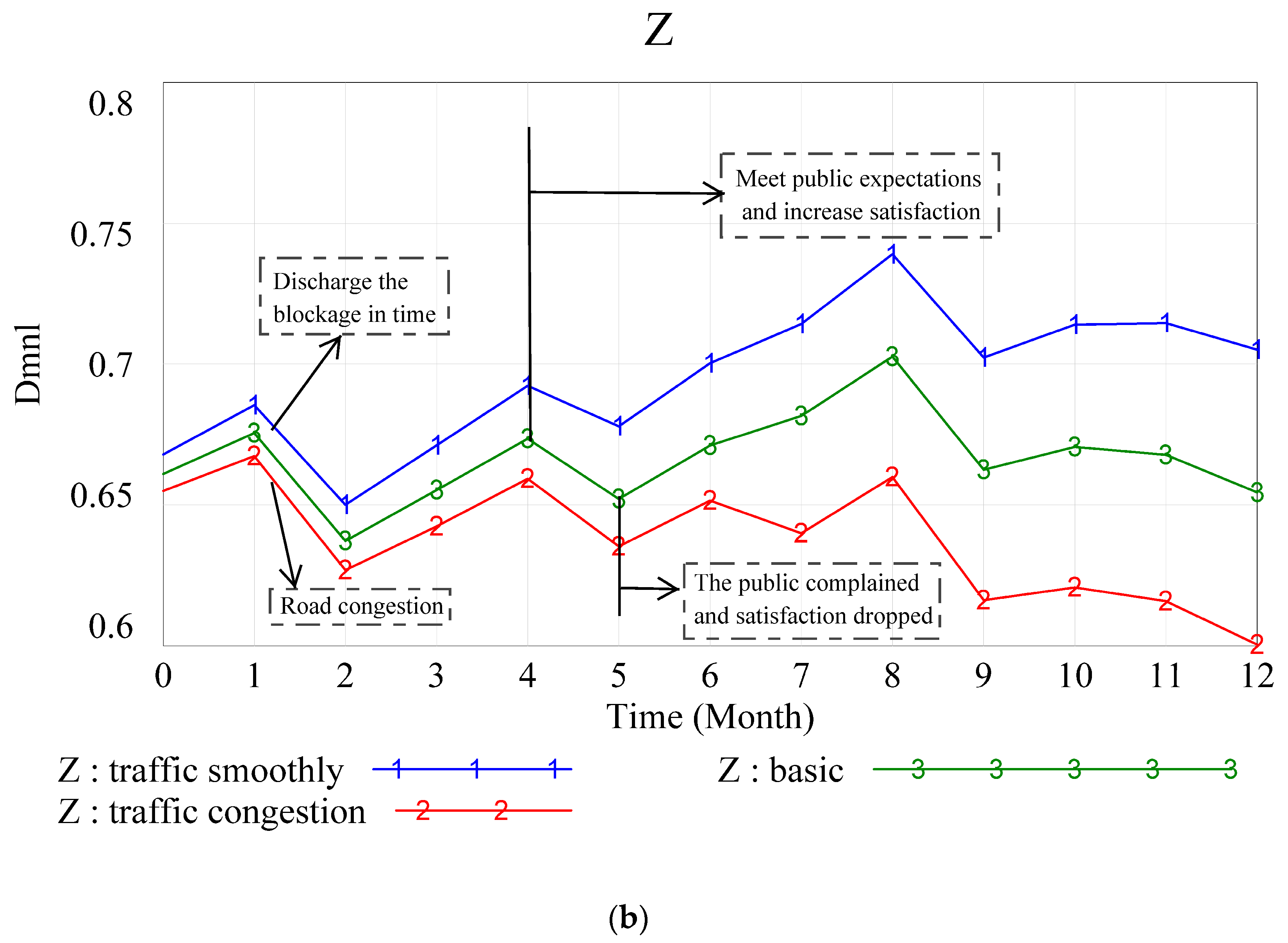
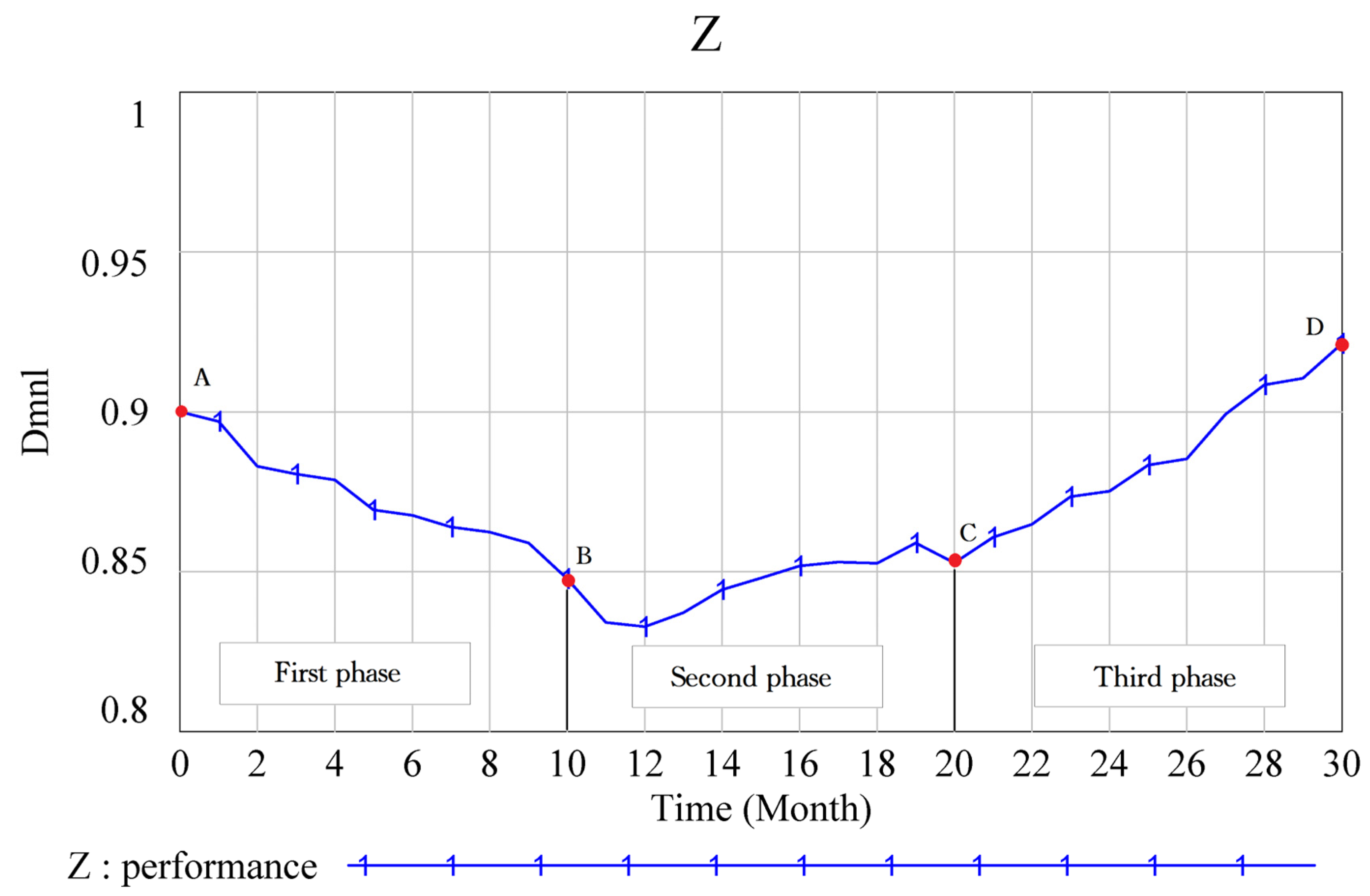
| Strategic Objectives | Concerning Aspects | Source |
|---|---|---|
| Finance | Solvency, operational capacity, growth capacity, etc. | [29,30] |
| Multi-stakeholder satisfaction | Private investors, government, facility managers and public, etc. | [14,17] |
| O&M | Reliability of facility or equipment, quality of service and information management etc. | [31,32] |
| Sustainability | Economic, environment, social, etc. | [15,19,26] |
| Source | Finance | Multi-Stakeholders’ Satisfaction | O&M | Sustainability | ||||||
|---|---|---|---|---|---|---|---|---|---|---|
| Public | Government | Investor | Reliability of Facility/Equipment | Quality of Service | Information Management | Economic | Social | Environment | ||
| [16] | √ | |||||||||
| [40] | √ | - | - | - | - | - | - | |||
| [18] | √ | √ | √ | √ | ||||||
| [41] | √ | - | - | - | √ | √ | √ | √ | ||
| [42] | √ | √ | √ | √ | ||||||
| [43] | √ | - | - | - | √ | √ | ||||
| [20] | √ | √ | √ | √ | √ | √ | √ | √ | ||
| Improved BSC | Second-Level Indicators/Source | Third-Level Indicators | Source | |
| Financial ability | Solvency (X1) | [30] | Short-term solvency (A1) | [58] |
| Asset liquidity (A2) | ||||
| Debt operating ability (A3) | ||||
| Operating capacity (X2) | Overall asset operating ability (A4) | [59] | ||
| Non-performing assets operating status (A5) | ||||
| Development capacity (X3) | Project revenue growth level (A6) | [60] | ||
| Project capital accumulation ability (A7) | ||||
| Multi- stakeholders’ satisfaction | Stakeholders’ satisfaction (X4) | [23] | Partnerships (A8) | [61] |
| Government satisfaction (A9) | ||||
| Investor satisfaction (A10) | ||||
| Social public satisfaction (A11) | ||||
| Environmental protection department satisfaction (A12) | ||||
| O&M | Facility Structural Condition (X5) | [18,40,41] | Technical status of civil structure (A13) | [25] |
| Technical status of electromechanical structure (A14) | ||||
| Operational service quality (X6) | Traffic flow levels (A15) | [62] | ||
| Road traffic quality (A16) | ||||
| Blockage removal ability (A17) | ||||
| Safety and emergency Management (X7) | Traffic safety level (A18) | [63] | ||
| Completeness of emergency plans (A19) | ||||
| The timeliness of emergency response (A20) | ||||
| Organizational Management (X8) | Integrity and clarity of the organizational structure (A21) | [64,65,66] | ||
| Integrity and implementation of management system (A22) | ||||
| Management information standardization and confidentiality (A23) | ||||
| Integrity and transparency of management process (A24) | ||||
| Degree of management information (A25) | ||||
| Management planning (A26) | ||||
| Sustainability | Sustainability (X9) | [19] | Economic sustainability impact (A27) | [15] |
| Social sustainability impact (A28) | ||||
| Environmental sustainability impact (A29) | ||||
| Variable Type | Variable Name |
|---|---|
| Horizontal variables | Financial ability, stakeholders, O&M management, sustainability, regulating subsystem |
| Rate variables | Financial changes, stakeholder satisfaction changes, O&M management changes, sustainability changes, and regulating subsystem changes. |
| Auxiliary variables | Project performance, development ability, solvency, operating ability, organizational management, safety and emergency management, operation services, structure, F1, F2, F3 |
| Constants | Project revenue growth rate, capital accumulation rate, current ratio, acid-test ratio, debt-to-asset ratio, total asset turnover, non-performing asset ratio, investor satisfaction, environmental protection department satisfaction, government satisfaction, social public satisfaction, partnerships, electromechanical structure, civil structure, management system integrity and implementation, management planning, management information standardization and confidentiality, degree of management information, organizational structure soundness and clarity, integrity and transparency of management process, emergency plan, accident rate, daily traffic, daily flow rate, timely rate of congestion removal, environmental sustainable impact, social sustainable impact, economic sustainable impact |
Disclaimer/Publisher’s Note: The statements, opinions and data contained in all publications are solely those of the individual author(s) and contributor(s) and not of MDPI and/or the editor(s). MDPI and/or the editor(s) disclaim responsibility for any injury to people or property resulting from any ideas, methods, instructions or products referred to in the content. |
© 2023 by the authors. Licensee MDPI, Basel, Switzerland. This article is an open access article distributed under the terms and conditions of the Creative Commons Attribution (CC BY) license (https://creativecommons.org/licenses/by/4.0/).
Share and Cite
Du, J.; Wang, W.; Gao, X.; Hu, M.; Jiang, H. Sustainable Operations: A Systematic Operational Performance Evaluation Framework for Public–Private Partnership Transportation Infrastructure Projects. Sustainability 2023, 15, 7951. https://doi.org/10.3390/su15107951
Du J, Wang W, Gao X, Hu M, Jiang H. Sustainable Operations: A Systematic Operational Performance Evaluation Framework for Public–Private Partnership Transportation Infrastructure Projects. Sustainability. 2023; 15(10):7951. https://doi.org/10.3390/su15107951
Chicago/Turabian StyleDu, Juan, Wenxin Wang, Xinghua Gao, Min Hu, and Haili Jiang. 2023. "Sustainable Operations: A Systematic Operational Performance Evaluation Framework for Public–Private Partnership Transportation Infrastructure Projects" Sustainability 15, no. 10: 7951. https://doi.org/10.3390/su15107951
APA StyleDu, J., Wang, W., Gao, X., Hu, M., & Jiang, H. (2023). Sustainable Operations: A Systematic Operational Performance Evaluation Framework for Public–Private Partnership Transportation Infrastructure Projects. Sustainability, 15(10), 7951. https://doi.org/10.3390/su15107951







